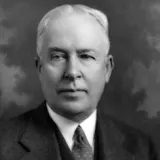
There was optimism in the air when Guy Winfred Bailey was elected thirteenth president of the university on June 16, 1920. Guy Bailey was the local lad who had made good — the son of a granite cutter from Essex Junction, who had served as president of his UVM class in 1900 and then gone on to a distinguished career in state government. Most Vermonters had expected him to run for governor or for national office, but instead he returned to his alma mater in 1917 to serve as its first comptroller.
Guy W. Bailey was born in Hardwick, Vermont, on May 7, 1876. His family later moved to Essex Junction where his father established the Bailey Granite Monument Company. Guy Bailey graduated from UVM in 1900, and was admitted to the Vermont bar in 1904. On December 22, 1904, he married Mabel G. Brigham of Essex Junction. He served in the Vermont House of Representatives in 1904 and 1906, and in 1908 he was elected secretary of state, a position he held until he resigned in 1917 to join the UVM administration. He had been appointed a trustee of the university in 1914 and had served as UVM’s acting president from August 1919 until his election in 1920.
In terms of his popularity, vitality, and experience, Bailey was the ideal choice to lead the university during the postwar years. In 1920 the first woman student was admitted to the College of Medicine, and in 1921 the university bought the Redstone property and began to develop it as a campus for women. In 1925 trustee James Wilbur of Manchester, Vermont, announced a major gift to construct the Ira Allen Chapel. Four years later, following his death in May of 1929, Wilbur left UVM a trust fund in excess of $2.5 million for scholarships and library use. During this same year, Slade Hall was built on Redstone Campus, and the Fleming Family gave a major gift to help build the Robert Hull Fleming Museum.
Construction slowed down in the 1930’s although two additional dormitories—Sander’s Hall and Allen House—were purchased and the Southwick Memorial Building was completed on Redstone Campus. During the Great Depression, President Bailey exercised a strong hand over all of UVM’s affairs. Nursing was added to the curriculum, student enrollments were held steady, and no faculty members were forced to take a cut in pay. Bailey provided sympathetic support for numerous students, and many stories circulated about how he personally helped to provide scholarships, jobs, and loans in particularly needy cases.
During the spring of 1939, President Bailey became confined to his home with a lingering disease of the bone structure. In the summer of 1940, plans were announced for a new central administration building as the result of a major gift from estate of Charles and Anna Waterman. After graduating from UVM in 1885, Waterman had settled in Denver where he established a distinguished law practice and served as United States Senator from Colorado. The Waterman Building cornerstone was laid in early October. Two weeks later, on October 22, 1940, President Bailey died in his home at the age of sixty-four. His wife was his sole survivor, their only son died in childhood.
Baileys’s death marked the end of an era. During his presidency from 1920 to 1940, total enrollments in all programs had grown from more than two thousand students, the faculty had increased almost three times in size and more than $3 million in new construction was completed, all but the Redstone Campus financed through outside gifts. President Bailey was a very strong leader who dominated the university. When he became ill in 1939, no one else possessed the authority to make major decisions. In the end, the results were tragic. Following Bailey’s death, startling facts concerning finances came to light, which revealed the university was running an estimated operating deficit of more than $500,000.
Once again UVM faced a devastating financial crisis. It was an unfortunate legacy for President Bailey who had served so faithfully for two decades. With the passage of time, many of the alumni conducted a campaign to restore Bailey’s image. Their efforts culminated in a book, Thank You, Guy Bailey, which recalled the kindnesses that Bailey had shown them during their student years. When the trustees decided to build a new library, they voted to name it in honor of Guy W. Bailey, “the thirteenth president of this university whose deep personal concern for the individual earned the affection and esteem of all whose lives touched him.”